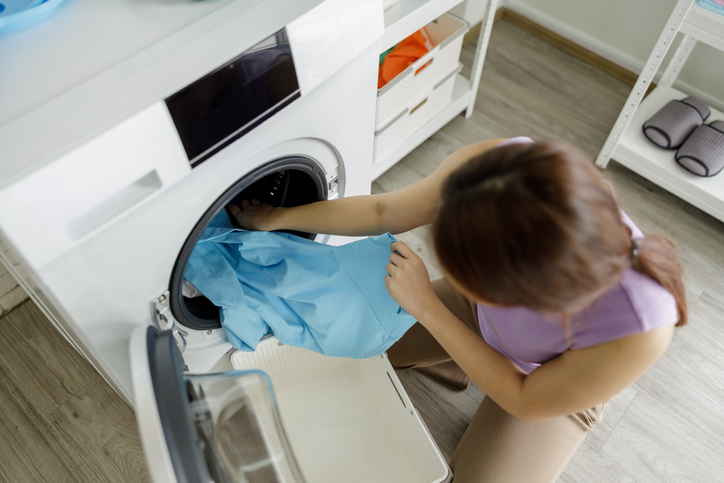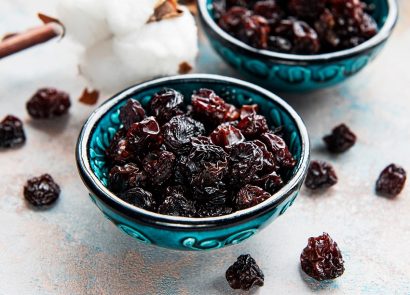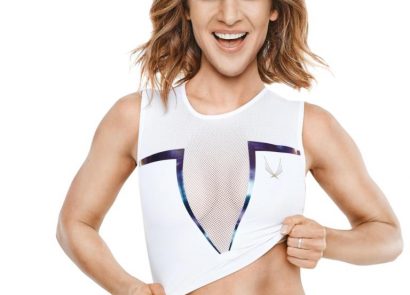Go on, admit it – when was the last time you properly wiped down your gym mat, or gave your trainers a decent clean? We’re all guilty of leaving our workout gear to fester in the washing basket before we get round to putting another load on – after all, sometimes simply finding the time to work out is hard enough – but, keeping your kit clean isn’t just good practice, it can also help ensure that you’re limiting your exposure to infection-causing bacteria and maintaining good physical health. Ready to get scrubbing? Our experts have all the advice you need…
Your trainers
Trainers looking a bit dirty? It can be tempting to pop them in the washing machine to give them a good clean – but according to James, this isn’t the best technique. “One reason for this is that the high temperature and chemicals within a wash cycle can actually melt the glue in the shoes, and in turn damage them,” he says, adding that by leaving your running trainers in water for a prolonged period of time you also risk damaging the soles, which could make your shoes less supportive.
Instead of this, James recommends a three pronged attack. “First of all, use a soft bristle brush to remove the top layer of loose dirt – failure to do this will result in the dirt getting embedded deeper into the material,” he says. “Then use a damp warm microfiber towel to begin the cleaning process, making sure that you cover the entire shoe. Once this is done, use a towel to pat down any damp areas before leaving the trainers to air dry.”
Your headphones
“Because they’re stuck in our ears all day, the crevices of our headphones can get coated with things like dry skin, ear wax and sweat,” says James Bickerstaff, a personal trainer from OriGym Centre of Excellence (origympersonaltrainercourses.co.uk). Cringing just thinking about it? Don’t worry – cleaning these little buds isn’t hard.
“I recommend using a paper towel dampened with rubbing alcohol to clean the surface of the headphones,” James says. “If you have ear cups over the speaker be sure to remove these in order to clean them separately. Repeat this process with a dampened cotton bud in order to clean the nooks of the headphones speakers, too.” James suggests doing this once a week to keep your listening pieces fresh and to reduce the risk of ear infections.
Your free weights
Do you have dumbbells or free weights in your kit at home? If so, make sure you’re regularly giving them a scrub down. “Ideally, weights should be cleaned after every use, especially in today’s world,” says Catherine McLaughlin, a personal trainer who works at gym equipment company BLK BOX (blkboxfitness.com). “These textured surfaces can be a haven for grime, bacteria and sweat. A simple scrubbing brush and good old-fashioned soap and water can be an ideal way to clean hand weights or for a deeper clean, use anti-bacterial wipes or spray disinfectant.”
If you’re heading to the gym to use the weights there, it’s also a good idea to use sanitising hand gel regularly and wipe down the equipment before and after use with an antibacterial wipe or spray.
Your protein shaker
If you’re an avid user of protein powder after your workouts, you’ll know how forgetting to clean your bottle can lead to a less-than-appealing build-up of residue and a stinky smell.
“When protein powder residue sits too long, it clumps up and becomes glue-like, making it really hard to clean,” says Catherine. It’s enough to put anyone off their favoured shake, but there are simple ways to keep your bottle fresh. “The best thing to do is to rinse it out with hot water as soon as you can after finishing your drink, and then clean it properly as you would any drinks bottle – either in the dishwasher or a sink of hot soapy water,” she suggests.
And, if you have left your protein shaker for too long before rinsing it out (we’ve all been there!), Catherine recommends soaking it in very hot water and washing up liquid for 10 minutes, before putting it in a dishwasher on a high rinse.
Your yoga mat
This trusty bit of kit shouldn’t be forgotten in your cleaning spree, especially when you consider what bacteria forming on the surface could do to your body. “After an intense class your exercise mat will have absorbed all of the sweat, grime and oil that your body has expelled,” James says, adding that a dirty mat can cause problems such as athlete’s foot, staph infections, plantar warts and ringworm.
“To avoid this, yogis everywhere swear by a mixture of distilled water, white wine vinegar and tea tree oil. Use this concoction in a spray bottle to squirt the mat before wiping it dry with a clean cloth. “Do this process once a month,” he advises.
Your gym kit
We pay extra attention when washing a special cashmere jumper or a silk dress, so why don’t we give our activewear the same care and thought? It’s fair to say these items work harder than all our other clothes – and could definitely do with some TLC. Sally Hughes, founder of sustainable clothing care brand Kair (kair.care), has these top tips to share…
Let it breathe: Though it’s tempting to throw all your sweaty, smelly activewear into the washing basket right after your workout, it’s important to give it room to breathe for a few hours so that the sweat can evaporate. Otherwise, odours and bacteria can linger for longer and transfer onto your other clothes too, and also become more difficult to wash out.
Keep it cool: High elastane content fabrics are vulnerable to heat damage: their fibres can shrink and lose elasticity when washed in high heat. So, always stick to cool temperatures (40C and below) to keep your workout kit in great shape. If your kit has zips, use a mesh laundry bag to help prevent the fabric snagging, stretching or tearing in the drum.
Use the right formula: Activewear is made from performance fabrics which wick away sweat, keeping you dry during your workout. But, stink-causing bacteria can get trapped, so it’s best to wash with a specifically designed activewear formulation. This will deep clean performance fabrics, removing perspiration and odours which may be lurking in the fibres, whilst preserving the integrity of high performance fabrics, so you can wear them workout after workout.
Avoid fabric conditioner: Fabric conditioner can impede the performance of moisture-wicking activewear fabrics, and also over time make it more difficult for your highstretch gym wear to retain its shape and form. So, while it’s dreamy for your bedding and most natural fibres, stay clear when taking your activewear for a spin.


























